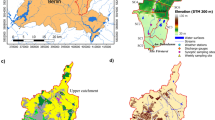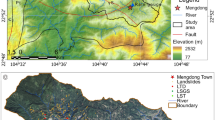Abstract
The changing land use due to rapid urbanization has profound impact on the runoff in urban watersheds. The spatial analysis in urban watersheds is felt necessary for management of surface and subsurface water regimes. Significant increase in impervious zones was observed in Nagpur urban watersheds between 2000 and 2012 having impacts on runoff, and even flash floods were observed. This study presents spatial and temporal impacts of change in urban built-up area on curve number (CN) and runoff during the years 2000 and 2012. The study also analyzes effect of slope on CN values and shows that CN increases with slope. High-resolution satellite images were used to map impervious surface areas (ISAs) which show an increase of 0.9 to 34 % during 2000–2012. Spearman’s and Pearson’s coefficients have been generated to establish relationship between runoff, impervious surface areas, vegetation index, slope, and runoff coefficient. It has been hypothetically assumed that if 100, 50, and 25 % rooftop rainwater harvesting is considered, the estimated runoff reduces in 2012 as compared to the year 2000. The study suggests that increase in impervious areas within urban watersheds can be utilized for groundwater augmentation adopting rooftop rainwater-harvesting techniques and to prevent flash floods.












Similar content being viewed by others
References
Centre for Science and Environment, CSE (2005) Legislation on rainwater harvesting: implementation of the bye-laws in different states and cities, http://www.cseindia.org/node/1111
Chabaeva A, Civco LD, Hurd DJ (2009) Assessment of impervious surface estimation techniques. J Hydrol Eng 14:377–387
Ciavola SJ, Jantz CA, Reilly J, Moglen GE (2014) Forecast changes in runoff quality and quantity from urbanization in the Delmarva peninsula. J Hydrol Eng 19(1):1–9
Han WS, Burian JS (2009) Determining effective impervious area for urban hydrologic modeling. J Hydrol Eng 14:111–120
Huang M, Gallichand J, Wang Z, Goulet M (2006) A modification to the soil conservation service curve number method for steep slopes in the loess plateau of China. Journal of Hydrol Process 20(3):579–589
IMD, Indian Metrological Department Pune. http://www.imdpune.gov.in/
Jacobson RC (2011) Identification and quantification of the hydrological impacts of imperviousness in urban catchments: a review. J Environ Manag 92:1438–1448
Jain PK, Paranjpe SC, Parchure PK (2012) Development, augmentation and management of groundwater resources of Nagpur metropolitan city. Gondwana Geological Magazine 27(2):209–216
Janice PDL, Aghaddir Ali (2016) Gulfnews Environment, http://gulfnews.com/news/uae/environment/fujairah-reels-under-flash-floods-1.1683735
Katpatal YB, Kute A, Satapathy DR (2008) Surface- and air-temperature studies in relation to land use/land cover of Nagpur urban area using Landsat 5 TM data. Journal of Urban Planning and Development 134(3):110–118
Katpatal YB, Rao RBVS (2011) Urban spatial decision support system for municipal solid waste management of Nagpur urban area using high resolution satellite data and geographic information system. J Urban Plan Dev 137(1):65–76
Matteo M, Randhir T, Bloniarz D (2006) Watershed-scale impacts of forest buffers on water quality and runoff in urbanizing environment. J Water Resour Plan Manag 132(3):144–152
Miller JD, Kim H, Kjeldsen TR, Packman J, Grebby S, Dearden R (2014) Assessing the impact of urbanization on storm runoff in a peri-urban catchment using historical change in impervious cover. J Hydrol 515:59–70
Mishra SK, Chaudhary A, Shrestha RK, Pandey A, Lal M (2014) Experimental verification of the effect of slope and land use on SCS runoff curve number. Water Resour Manag 28:3407–3416
Nagarajan N and Poongothai S (2012) Spatial mapping of runoff from a watershed using SCS-CN method with remote sensing and GIS. J Hydrol Eng :1268–1277
Sharpley AN, William JR, 1990. EPIC-erosion/productivity impact calculator: 1. model determination. US Department of Agriculture. Tech Bull, No. 1768
Soil Conservation Service (SCS) (1956) “Hydrology.” supplement a, section 4, chapter 10, national engineering handbook. USDA, Washington, DC
Suiji W, Yunxia Y, Ming Y, Xiaokun Z (2012) Quantitative estimation of the impact of precipitation and human activities on runoff change of the Huangfuchuan river basin. J Geogr Sci 22(5):906–918
Suribabu CR, Bhaskar J (2015) Evaluation of urban growth effects on surface runoff using SCS-CN method and green-Ampt infiltration model. Journal of Earth Sci Inform 8:609–626
Suribabu C.R., T.R. Neelakantan (2013). Empirical formula for finding 15 minute maximum rainfall from n-hr rainfall and disaggregation model of n-hr rainfall, J Appl Hydrol XXVI(1–4)
Suribabu CR, Bhaskar J, Neelakantan TR (2012) Land use/cover change detection of Tiruchirapalli City, India, using integrated remote sensing and GIS tools. Journal of Indian Society of Remote Sensing 40(4):699–708
Tessema SM, Lyon SW, Setegn SG, Mortberg U (2014) Effects of different retention parameter estimation methods on the prediction of surface runoff using the SCS curve number method. Journal of Water Resource Management 28:3241–3254
Thanapura P, Helder DL, Burckhard S, Warmath E, Neill MO, Galster D (2007) Mapping urban land cover using QuickBird NDVI and GIS spatial modeling for runoff coefficient determination. Journal of Photogrammetric Engineering and Remote Sensing 73(1):057–065
Wenhui K (2012) Evaluating impervious surface growth and its impacts on water environment in Beijing-Tianjin-Tangshan metropolitan area. J Geogr Sci 22(3):535–547
Yan H, Edwards FG (2013) Effects of land use change on hydrologic response at a watershed scale, Arkansas. J Hydrol Eng 18:1779–1785
Yoo C, Kim K, Park M, Yoon J (2013) Quantification of flood runoff reduction effect of storage facilities by the decrease in CN. J Hydrol Eng 18(6):729–733
Zhang Y, Shuster W (2014) Impacts of spatial distribution of impervious areas on runoff response of hillslope catchments: simulation study. J Hydrol Eng 19:1089–1100
Author information
Authors and Affiliations
Corresponding author
Rights and permissions
About this article
Cite this article
Ansari, T.A., Katpatal, Y.B. & Vasudeo, A.D. Spatial evaluation of impacts of increase in impervious surface area on SCS-CN and runoff in Nagpur urban watersheds, India. Arab J Geosci 9, 702 (2016). https://doi.org/10.1007/s12517-016-2702-5
Received:
Accepted:
Published:
DOI: https://doi.org/10.1007/s12517-016-2702-5




